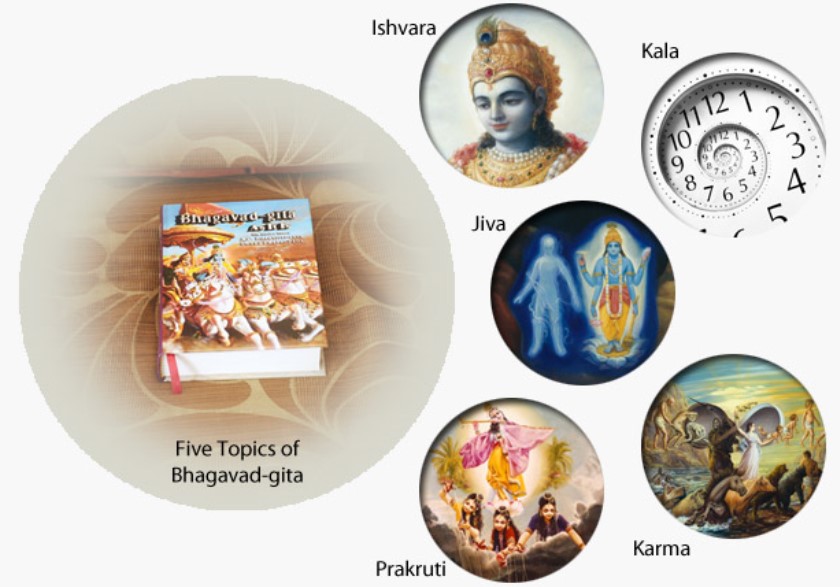Five Basic Truths of Bhagavad Gita – Bhagavad Gita, also called as Gitopanishad, is the crest jewel of all Vedic compositions. It is unique in the sense that no other Vedic or Western spiritual literature has God Himself speaking. He is actually a dialogue between Lord Krishna and Arjuna on the battlefield of Kurukshetra. It impels one to undertake a serious search for the Absolute truth. It is incorrect to label Bhagavad Gita as a Hindu religious book,. In fact the word ‘Hindu’ appears nowhere in the Vedas.

It would be more apt to call Bhagavad Gita a science – the science of the self. The science that is spoken here is applicable for all irrespective of caste, creed, religion or gender.It is meant for thinkers from all walks of life and it turns every reader into a positive thinker. Through the ages, Bhagavad Gita has inspired and guided hosts of philosophers and scientists all across the world. It has been translated into almost every language of the modern world. Just like the Quran and the Bible are known all across the globe, Bhagavad Gita is also widely respected as the topmost theistic science.
Table of Contents
Main 5 topics of Bhagavad Gita
The essence of Bhagavad Gita can be well understood by knowing its five main topics – Isvara (God), Jiva (living entity), Prakriti (Material Nature), Kala (time), and Karma (Action).
1. Ishvara (God) -Our Supreme Father
All of us are control by someone or the other in our lives. A child is control by the teacher at the school and by the parents at home. A man or woman is control by the boss at the office. Even the head of the state is also control by many factors. Ultimately, everyone is under the strict control of Nature and its laws. At the most, one can perceive the unfailing control of Nature over everyone. But even in nature, we see perfect orderliness – seasons come on time; Sun and moon appear and disappear at definite times of the day.Thus, one can further ask, “Who is the ultimate controller of everything?”
In the Bhagavad Gita, Lord Krishna declares that He is the ultimate proprietor, controller and enjoyer of everything. He explains that the material nature is functioning under His guidance. Declares that the entire cosmic manifestation is create, maintaine and annihilated repeatedly under His will. He is the source of all spiritual and material worlds. All material manifestations emanate from Him and enter into Him at the time of annihilation.
Everything that is animate or inanimate is a manifestation of one of His energies – material or spiritual.In His unmanifested form, He pervades everything and all beings are in Him. He explains that He is the Supersoul, sitting in the heart of all living entities – giving them the power to remember, understand and forget. Declares that the supreme attainable destination for anyone is His personal abode – Goloka Vrindavana. He explains that one can reach this abode only by rendering unalloyed devotional service unto Him.
The Bhagavad Gita is very clear that God is neither abstract nor impersonal. It declares God to be Krishna, the Supreme Person. He is not judgmental or envious but a loving and lovable person. The sweetest aspect of Bhagavad Gita is that it glorifies the relationship between Krishna and His devotees – how they serve Him unconditonally and how He reciprocates with them affectionately.
2. Living entity (Jiva) – Who we are?
Almost all of us identify ourselves with the body that we inhabit. We consider ourselves to be either male or female; Punjabi or Gujarati; Indian or American; Hindu or Muslim. But these are just the identities that our bodies assume. Sometimes we say, “My body is aching today”. At other times, we say, “My mind is disturb today”. ‘Whose’ body or mind are we referring to here? Have we ever wondered who this real “I” is? Similarly, when someone dies, it is common to say, “He has passed away”. Why do we say this if the body is lying right in front of us?
It is the soul that energizes the body and makes it work. When the soul leaves the body, it exhibits no symptoms of consciousness. The soul cannot be seen or heard; it cannot be felt or perceived; Just for an estimate, it is said that the soul is very tiny in size – as small as one-thousandth the tip of a strand of hair. The presence of soul can be understood only by the symptom of consciousness that it produces in a material body. It is this soul that moves or migrates from one body to the other. This process of migration of the soul from one body to the other is called ‘reincarnation’. When the soul migrates from one body to the other, it carries along with it different impressions from the current body. This concept of reincarnation alone can explain for the differences we see around us.
In the Bhagavad Gita, Lord Krishna further explains that every living entity (jiva or the soul) is His eternal part and parcel. Krishna is the Supreme Whole and we are His eternal parts and parcels. All our present suffering is due to our disdainful ignorance of this aspect in our life. For example, a key that opens a lock has no separate existence of its own. If we lose it somewhere, no one can use it for any purpose.
3. Nature (Prakriti)- Like our Mother
Material nature and God can be compare to the mother and father of all living entities. In this world, we can see that the father impregnates the mother with the child. Similarly,Lord Krishna declares in the Bhagavad Gita that he is the seed-giving father of all living entities. He impregnates the material nature with all living entities. Just like the mother nourishes the child by providing all eatables, Mother Naturenourishes all living beings with everything necessary for their sustenance. Food for all is amply provided by nature. Any scarcity is to be understood as artificial or man-made.
Everyone can more or less relate to the fact that Nature is like the mother. However, most ill-informed people are tricked to think that material nature acts independently without any controlling authority. Lord Krishna, in the Bhagavad Gita, however, declares that the material nature is working under His direction. This is easy to understand. We can judge by our day-to-day experience how a material object cannot move on its own.
For example, a car transports us from one place to the other. However, it does not move on its own – it is driven by a living force – a person. Similarly, matter cannot act on its own; it has to be driven by a living force. Sometimes, out of foolishness, man thinks that he can control nature. He might control nature to a very small extent. But he is completely control by nature. A heavy downpour of rain for few hours could drown even the most sophisticated cities of the world! Furthermore, nature controls every living being through the three modes – goodness, passion and ignorance.
4. Kala (Time)- The Invincible Power
Time, as a feature of Lord Krishna, destroys everything. In our day-to-day experience, we can see how everything deteriorates with time. Everything and everyone are subject to the cruel laws of time. Time and tide wait for none! Bhagavad Gita further explains that time is relative and cyclical – A set of four Yugas namely Satya, Treta, Dwapara and Kali repeat themselves in a cyclic fashion. One day of Brahma constitutes 1000 such cycles and the same number makes his one night.
The lifetime of a universe is 100 years of Brahma’s lifetime. That Brahma lives for 311 trillion and 40 billion earth years might seem wonderful to many and even silly to some. However, this is not difficult to understand. There are many flies and worms that take birth, grow, reproduce and die in a matter of few hours of our time. For these creatures, our lifetime of 70 or 80 years might also seem too long!
5. Karma (Action)- What is Yoga?
Karma is the most discussed topic of the Bhagavad Gita. It means the form of duty that liberates us from the influence of ignorance. In our current situation, we are suffering due to forgetting our relationship with God. There are different methods of Yoga describe in the Bhagavad Gita – Karma Yoga (path of action where one works only for the Supreme), Jnana Yoga (path of knowledge about the Supreme), Dhyana Yoga (path of meditation on the Supreme) and Bhakti Yoga (path of loving devotional service unto the Supreme). Of all these paths, Bhakti Yoga is the direct, easiest and quickest path to attain the Supreme Lord – Sri Krishna.
Conclusion
The most important message of Bhagavad Gita is that one should perfect one’s life and purify one’s existence by connecting to God – Krishna, by the process of rendering devotional service unto Him. By doing so, one becomes happy and satisfied under all circumstances
A sincere reader of the Gita keeps depression at a distance. Failures do not affect such a person. He moves ahead in life with faith and confidence in the Supreme. By regular reading of the Bhagavad Gita one becomes cool and clear in his thought process. One becomes very efficient in everything one does. One can take quick and correct decisions. By sincere reading of the Bhagavad Gita and application of the same in one’s life, one becomes simple and humble in one’s dealings in this world. He becomes successful in all his relationships. He is happy and contended in this world and thereafter.



